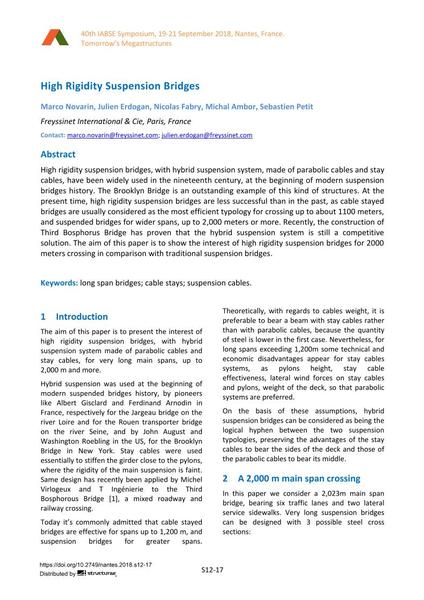High Rigidity Suspension Bridges

|
|
|||||||||||
Bibliographic Details
| Author(s): |
Marco Novarin
(Freyssinet International & Cie, Paris, France)
Julien Erdogan (Freyssinet International & Cie, Paris, France) Nicolas Fabry (Freyssinet International & Cie, Paris, France) Michal Ambor (Freyssinet International & Cie, Paris, France) Sébastien Petit (Freyssinet International & Cie, Paris, France) |
||||
|---|---|---|---|---|---|
| Medium: | conference paper | ||||
| Language(s): | English | ||||
| Conference: | IABSE Symposium: Tomorrow’s Megastructures, Nantes, France, 19-21 September 2018 | ||||
| Published in: | IABSE Symposium Nantes 2018 | ||||
|
|||||
| Page(s): | S12-17 | ||||
| Total no. of pages: | 8 | ||||
| DOI: | 10.2749/nantes.2018.s12-17 | ||||
| Abstract: |
High rigidity suspension bridges, with hybrid suspension system, made of parabolic cables and stay cables, have been widely used in the nineteenth century, at the beginning of modern suspension bridges history. The Brooklyn Bridge is an outstanding example of this kind of structures. At the present time, high rigidity suspension bridges are less successful than in the past, as cable stayed bridges are usually considered as the most efficient typology for crossing up to about 1100 meters, and suspended bridges for wider spans, up to 2,000 meters or more. Recently, the construction of Third Bosphorus Bridge has proven that the hybrid suspension system is still a competitive solution. The aim of this paper is to show the interest of high rigidity suspension bridges for 2000 meters crossing in comparison with traditional suspension bridges. |
||||
| Keywords: |
Long span bridges cable stays suspension cables
|
||||

